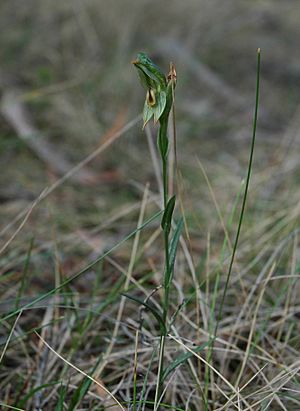Black-striped leafy greenhood facts for kids
Quick facts for kids Black-striped leafy greenhood |
|
|---|---|
 |
|
| Pterostylis melagramma growing in southern Tasmania | |
| Scientific classification | |
| Genus: |
Pterostylis
|
| Species: |
melagramma
|
| Synonyms | |
|
|
The Pterostylis melagramma, often called the black-stripe leafy greenhood, is a fascinating plant from the orchid family. It is found only in south-eastern Australia, meaning it is endemic to that area.
This plant can appear in two ways. Some plants have a group of three to six leaves that grow in a circle, like a rosette. Other plants grow a tall stem with up to twenty flowers. These flowers are a beautiful translucent green with faint darker lines. They also have a brownish-yellow part called a labellum (a special lip-like petal) with a dark stripe.
Contents
What Does the Black-striped Leafy Greenhood Look Like?
The Black-striped Leafy Greenhood (Pterostylis melagramma) is a perennial plant, which means it lives for more than two years. It's also a deciduous herb, so its leaves and stems die back each year, but it regrows from an underground tuber (a bit like a potato).
Leaves of the Greenhood
Plants that are not flowering have a group of leaves at their base. These leaves are narrow and egg-shaped, about 13 to 50 millimeters (about 0.5 to 2 inches) long and 4 to 11 millimeters (about 0.15 to 0.4 inches) wide. They grow on a stalk that is 30 to 100 millimeters (about 1 to 4 inches) tall.
Flowers of the Greenhood
When the plant flowers, it grows a tall spike that can be 150 to 800 millimeters (about 6 to 31 inches) high. This spike can have up to twenty see-through flowers with faint darker lines. The flowering spike also has five to seven leaves along its stem, each about 25 to 80 millimeters (about 1 to 3 inches) long and 5 to 10 millimeters (about 0.2 to 0.4 inches) wide.
The individual flowers are about 13 to 15 millimeters (about 0.5 inches) long and 4 to 8 millimeters (about 0.15 to 0.3 inches) wide. The top part of the flower, called the dorsal sepal, and the petals join together to form a hood. This hood covers the central part of the flower. The tip of the dorsal sepal often curves downwards and can be brown.
The two lower sepals turn downwards and are joined together for about half their length. They are about 11 to 13 millimeters (about 0.4 to 0.5 inches) long. The labellum, which is the special lip-like petal, is about 5 millimeters (0.2 inches) long and 2 millimeters (0.08 inches) wide. It is brownish-yellow, has tiny hairs, and a dark stripe down its middle.
This orchid usually blooms between June and November.
How It Got Its Name
Taxonomy and Naming
The Pterostylis melagramma was officially described for the first time in 1998. This was done by a botanist named David Jones. The description was published in a scientific paper called Australian Orchid Research.
The second part of its scientific name, melagramma, comes from two ancient Greek words:
- melas or melanos, which means 'dark' or 'black'.
- gramme, which means 'line'.
So, melagramma refers to the dark stripe you can see on the labellum of the flower.
Where Does It Live?
Distribution and Habitat
The black-stripe leafy greenhood is quite common and can be found in areas with higher rainfall. It grows in Victoria and Tasmania. You can also find it in south-eastern South Australia and southern New South Wales.
Is It Protected?
Conservation Status
In South Australia, the black-stripe leafy greenhood is considered "endangered." This means there are not many of these plants left in the wild in that area, and they need special protection to survive.

